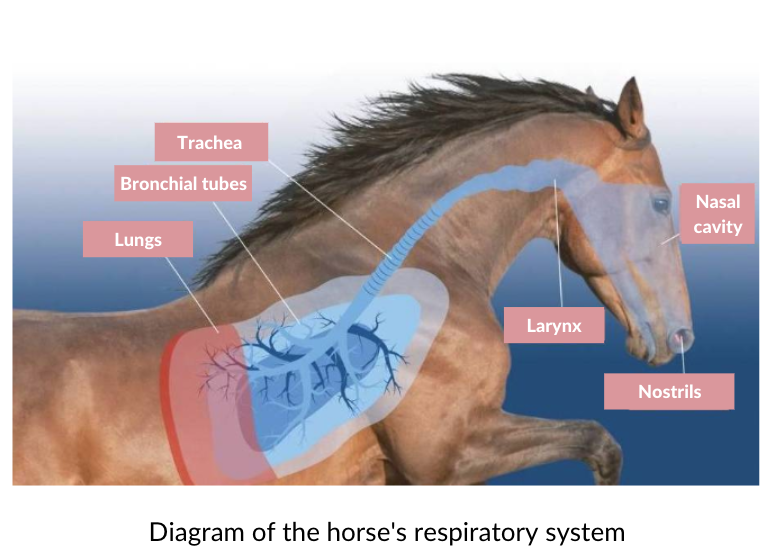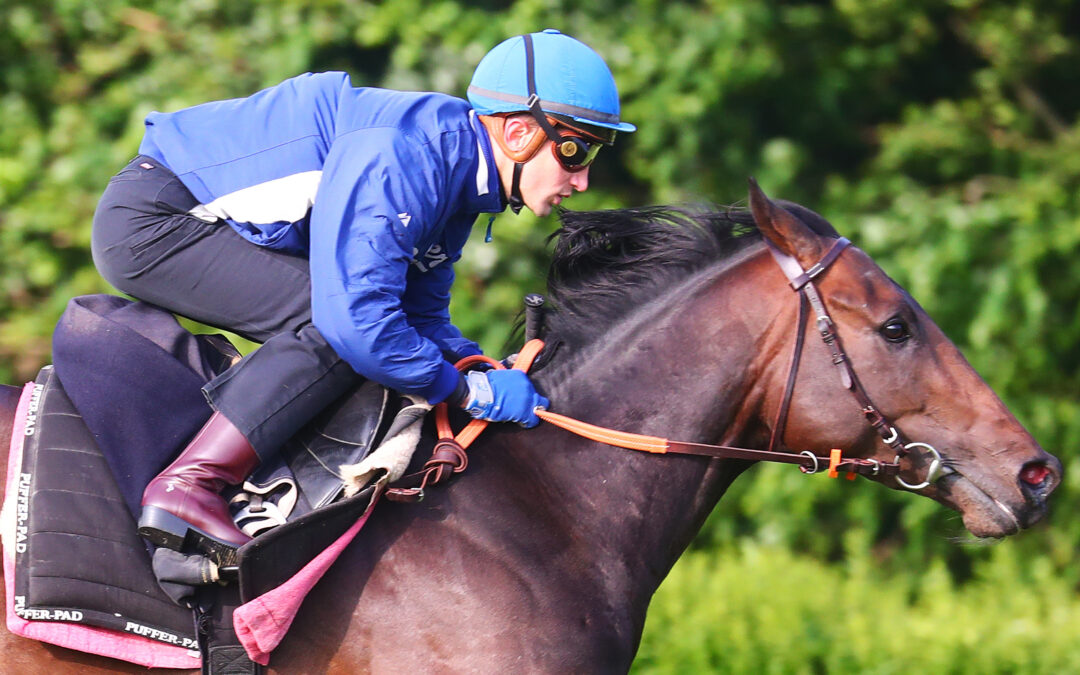The respiratory system’s function is to make use of the oxygen that is freely present in the air we breathe. The horse’s lungs and respiratory system depend on them to operate correctly, not only because of their size but also because of their vital functions. Indeed, the horse must have efficient respiratory capacity if it wishes to sustain the pace of its activity while adequately supplying its body with oxygen and eliminating carbon dioxide. The horse’s respiratory system is, in a way, the engine that drives all the other organs, particularly its heart.
How does the respiratory system of the horse work during training? How can its impact be quantified?
In recent decades, research on exercising horses has provided increasing evidence that the respiratory system can be a limiting factor for maximum performance, even in healthy animals (Art et al., 1990a; Bayly et al., 1983; Bayly et al., 1987; Erickson et al., 1991; Hodgson et al., 1990; Jones and Lindsdtedt, 1993; Knight et al., 1991; Poole, 2004; Thornton et al., 1983; Wagner et al., 1989). Therefore, any pulmonary dysfunction, even subclinical or moderate, can significantly impair the aerobic metabolism of horses during exertion. The observation that respiratory abnormalities are frequently responsible for the “poor performance” syndrome in horses (Arthur, 1990; Evans and Marlin, 1999; Franklin et al., 2012; McNamara et al., 1990; Morris and Seeherman, 1991) confirms the importance of optimal lung function in the athletic horse. A good understanding of the unique characteristics of equine respiratory structure and function is essential for a comprehensive evaluation of the respiratory system and the potential correction of its dysfunctions.
How the respiratory system works
The respiratory system of the horse is made up of three key elements:
- The airways are the interface between the external air and the lungs.
- The pulmonary alveoli are the spaces between the air and the blood where gas exchange happens.
- The thoracic cage muscles that control the volume of the alveoli and, as a result, the gas exchange that happens in these alveoli.

The primary function of the lung is gas exchange, which facilitates the transport of oxygen (O2) from the air to the blood and carbon dioxide (CO2) in the opposite direction.
Horses, unlike humans, are unable to open their mouths to breathe. They must open their noses to boost their breathing capacity. Because of the face muscles, the dilatation of the nostrils permits a huge amount of air to move through the airways.
Indeed, similar to heart rate, the horse’s respiratory rate varies depending on its activity:
-
-
- At rest: between 10 and 12 breaths per minute
- At a walk: 18 breaths per minute
- After 5 minutes of trotting: 52 breaths per minute
- After 5 minutes of galloping: 78 breaths per minute
-
Each respiratory cycle consists of an inhalation phase – 80% nitrogen, 20% oxygen, and traces of carbon dioxide – and an exhalation phase. During exhalation, oxygen levels fall to 15% and carbon dioxide levels rise to 5%.
At rest, a horse inhales 66 litres of air per minute and has a lung capacity of 50 litres. One peculiarity of the horse’s respiratory system is the unnecessary volume of air it inhales. Approximately 60% of the air inspired by the horse remains in its nostrils, trachea, and larynx.
The type of exercise undertaken influences changes in alveolar ventilation and the dead space-to-tidal volume ratio in horses. The amount of dead space does not vary considerably after light to moderate activity. As a result, increasing tidal volume increases alveolar ventilation while decreasing the dead space-to-tidal volume ratio.
If exercise is prolonged at a constant rate, dead space ventilation will increase with a simultaneous increase in alveolar ventilation.
This adaptation probably reflects the thermoregulatory role of the respiratory system. Finally, during intense exercise, this ratio decreased from around 60% to 20%. In absolute terms, the physiological dead space is reduced from 3.5 L at rest to 2.5 L during intense exercise.
Training-induced physiological changes in the respiratory system
The horse’s respiratory system’s function is to transport oxygen from the air the horse inhales to the blood and subsequently to the muscles. Although the respiratory system is already well-developed, its transformation through training is limited.
Indeed, training does not allow the horse to increase the volume of its lungs, but it does enhance its ability to use the inhaled and exhaled air. Through regular exercise, the walls of the heart thicken, enabling more efficient air pumping. This contributes to improved oxygen transport and ultimately enhances aerobic capacity.
A horse that undergoes regular exercise will therefore be in better respiratory condition, by optimising the strength and resistance of its respiratory muscles.
This phenomenon is particularly observed in young horses. The study proposed by Hiraga et al (1997) states that an increase in the intensity and duration of training over a period of 8 weeks resulted in a 7% increase in VO2 max in 2-year-old thoroughbreds – at the start of their training.
Knight et al (1991) showed in another study that significant increases in VO2 max were observed during the first two weeks of training. It is during this period that cardiac capacity improves in young horses.
These results indicate that even low-intensity exercise can have an effect on cardiopulmonary function during the early stages of training.
However, to maintain a healthy respiratory system, the horse must be in good condition outside of training. The primary reason of underperformance is respiratory diseases such as asthma. As a result, maintaining adequate air quality within the stable is critical.
To learn more, we recommend reading this article on the influence of air quality in the stable.
How to measure the respiratory capacity of an athletic horse?
- Spirometry: breathing measurement test that measures the volume of air inhaled and exhaled
- VO2 max : the maximum volume of oxygen that an aerobic organism can consume per unit of time during maximum dynamic aerobic exercise.
Oxygen consumption (VO2) is a linear function of speed. As speed increases, oxygen demand rises until it reaches a maximum: VO2 max. If this demand is not fulfilled, the energy used is consumed without oxygen: this is the anaerobic phase of the workout.
To learn more, we recommend reading this article on energy creation in athletic horses
Training can be classified according to the percentage of VO2 max. It increases with exercise, mainly during the first few weeks. The oxygen not supplied during work constitutes the oxygen debt. This debt must be compensated after exercise stops. This causes a gradual drop in VO2, as well as heart and breathing rates.
- Lactate level: metabolite of glucose produced by the body’s tissues when the oxygen supply is insufficient.
Lactate levels are therefore an indicator of oxygen deficiency or hypoxaemia (low levels of oxygen in the blood). It can be measured, for example, to estimate the severity of a horse’s colic or hospitalisation for intensive care. A lactate level of more than 8 mmol/L suggests a severe case.
The anaerobic threshold in racehorses is established at 4 mmol/L lactate. Above this point, the horse is considered oxygen-deficient.
Conclusion
Training has no real effect on the horse’s respiratory system, as it is not possible to increase the ventilation capacity of the lungs or the rate of gas exchange (oxygen and carbon dioxide). However, a dysfunctional respiratory system is one of the main sources of poor performance in horses, as it supplies the muscles and heart.
It is therefore important to measure the respiratory rate frequently in order to detect potential pathologies.
There is clear value in incorporating pulmonary function assessment into health monitoring. It allows an accurate assessment of the horse’s respiratory function, which is essential, particularly when looking at counter-performance.
SOURCES :
www.vitalherbs.be. (n.d.). Vitalherbs articles. [online] Available at: https://www.vitalherbs.be/fr/nos-articles/2019-12-08-asthme-emphyseme-allergies-pathologies-respiratoires-l-intestin-permeable-leaky-gut [Accessed 13 Jul. 2023].
HIRAGA, A., KAI, M., KUBO, K. and SUGANO, S. (1997). The Effect of Training Intensity on Cardiopulmonary Function in 2 Year-Old Thoroughbred Horses. Journal of Equine Science, 8(3), pp.75–80. doi:https://doi.org/10.1294/jes.8.75.
HIRAGA, A., KAI, M., KUBO, K. and SUGANO, S. (1997). Effects of Low Intensity Exercise during the Breaking Period on Cardiopulmonary Function in Thoroughbred Yearlings. Journal of Equine Science, 8(1), pp.21–24. doi:https://doi.org/10.1294/jes.8.21.
Hodgson, D.R., Kenneth Harrington Mckeever and Mcgowan, C.M. (2014). The athletic horse : principles and practice of equine sports medicine. St. Louis: Saunders/Elsevier.
Key words: respiratory system, equine physiology, training, lungs, horse athlete, equine veterinary surgeon
Photo credit: @scoopdyga

